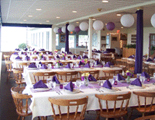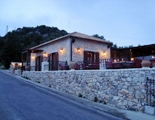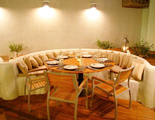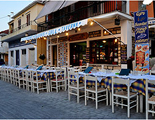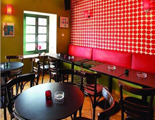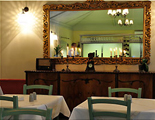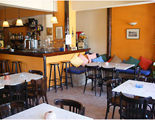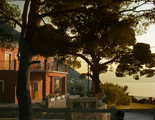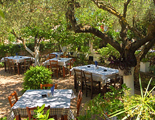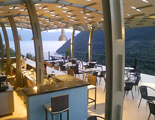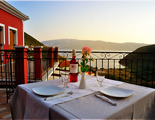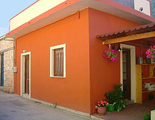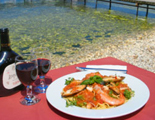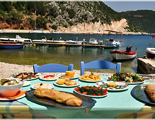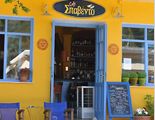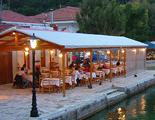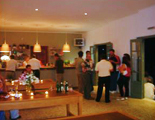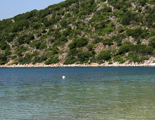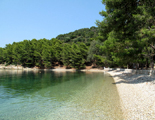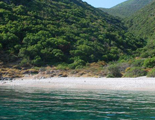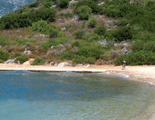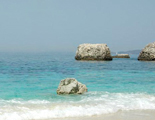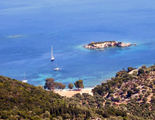
Ithaca Travel Guide
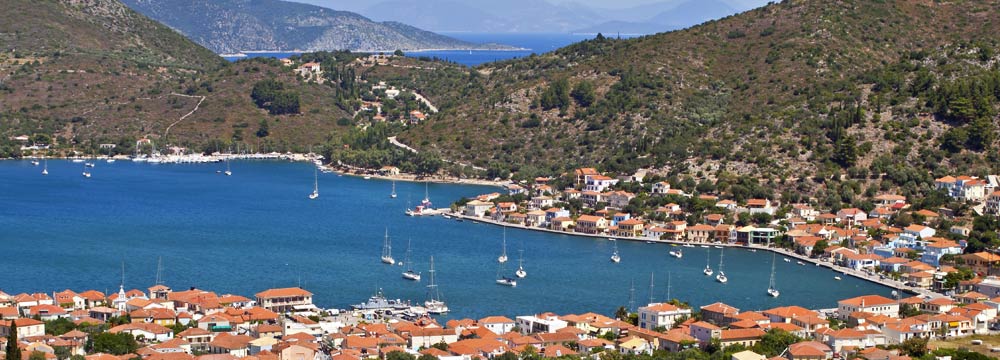
History
Ithaca Name
Several theories exist regarding the origin of Ithaca’s name. According to one of them, the name derives from Ithakos who was the first inhabitant of the island along with his two brothers, Niritos and Polyktoras.
Another version supports that the name comes from the Greek word “Ithi” (which means “merry”) or from “Ithis” (meaning “abrupt”). It is also believed that “Ithaca” could derive from the Phoenician word “Utika” (which means “colony”).
Generally the name of the island has remained intact since the ancient times. According to ancient documents that have come to light, though, and refer to different periods of time, the island has must have had other names too.
For example, from the Middle Ages till the end of the Venetian period the names “Val di Compare” (“Valley of the Bestman”), Piccola (“Small”) Kefalonia, Antikefalonia, Thiaki and Teaki were used.
In the Byzantine period it was called nisos (island) Ithaki, Thrakoniso, Thakou, Thiakou while during the Turkish Occupation the island was known under the name Fiaki.
First settlers
The island has been inhabited since the Neolithic Period (4000-3000 B.C.), as proved by a number of remnants discovered including traces of buildings and walls, but there is not sufficient evidence on the origin of the inhabitants. There are also findings in the settlement of Pilikata and at Loizo’s Cave in Polis settlement dating back to the Early Hellenic era (3000–2000 B.C.).
Mycenaean Era
During the Mycenaean period (1500–1100 B.C.), the island reached great prosperity as revealed by the findings from that period. Based in Homer’s epic poems it is believed that Ithaca ruled the surrounding islands and part of the opposite mainland. “Iliad” and “Odyssey” are believed to have been composed in the 8th century B.C., so information we have now concerning the political geography, customs and the structure and mechanism of the society of that period is deducted through those two masterpieces.
Hellenistic Era
The findings that were brought to light from the excavations in the areas of Aetos and Alalkomenes date back to the Hellenistic period (800–180 B.C.). Among the objects found were a number of coins with the scribe “Ithaca”, the image of Odysseus and a temple of God Apollo which suggest that an organized way of living and an autonomous state existed during that period.
Roman Era - Venetian Era
During the Roman Era (180 B.C. – 394 A.D.), Ithaca was an Illyrian province and right after, in the Byzantine years (394–1185 A.D), Christianity was established. From 1086 the island was raided by the Vandals, the Goths and the Saracenstill it was eventually reigned by the Normans in 1185.
During the Middle Ages, the population of Ithaca remarkably decreased due to pirate raids and the locals were forced to leave the coast and establish settlements on the mountains.
In 1200 Ithaca is granted to the Roman family Orsini and in 1357 king Richard of Naples grants it to Leonard Toque until 1479.
In 1479 the Turks conquered the Ionian islands of Lefkada, Kefalonia, Zakynthos and Ithaca and the local population abandoned the island to escape slavery or death.
In 1499 the Venetians got interested in the Ionian Sea and begun a war against the Turks which they won with the help of the allied forces of Spain. With the treaty of 1503, Ithaca, Kefalonia and Zakynthos remained under the Venetian rule while Lefkada was under the Turkish. The Venetians tried to develop the economy of Ithaca and granted tax exemptions to the locals. The population increased and Vathy became the capital of the island while the main agricultural product of the island was the raisin.
Piracy was also successfully fought by building ships and gradually Ithaca created a strong and significant fleet which eventually participated in many naval combats such as the Orlov Revolt (1768-1774) between the Russians and the Turks.
French Era
A few years after the French revolution the Ionian Islands came under the rule of the French (First French Republic). They formed the French department of Ithaca which included Kefalonia, Lefkada and a part of the Greek Mainland along with Ithaca which was the department’s capital.
The Russians and the Turks succeeded the French at the end of 1798 and they formed the Ionian states with the island of Corfu as its capital. The government was democratic and Ithaca had one representative in the senate which was formed by fourteen members.
In 1807 until 1809 the Ionian islands came under the French rule again, after an agreement with Turkey. They built a fort in Vathy and prepared to combat the British fleet.
In 1809 the British conquered the Ionian islands including Ithaca and formed the United States of the Ionian Islands. Ithaca was then represented by one member in the Ionian Parliament.
The Greek Revolution of 1821
During the Greek Revolution in 1821 against the Turks many locals participated in the war and twenty Ithacans were among the founding members of “Filiki Etairia”, which was the organization behind the Revolution. The island was also a refuge for civilians and fighters during the Revolution and it finally joined the Greek State in 1864.
Modern Ithaca
During the First World War many locals migrated to the USA, Australia and South Africa. During the Second World War all the Ionian Islands came under Italian occupation until 1943 and under German occupation until 1944. Due to the wars, occupation, migration and the catastrophic earthquakes in 1953 the population of Ithaca was reduced dramatically.
Today the natural environment is preserved in a great degree despite the fact that tourism is a pillar of the local economy, mainly because of the geomorphology of the island. Ithaca’s architecture has also been influenced and affected by the Venetians and the French which ruled the island in the past.
Mythology
Ithaca Mythology
Odysseus was the mythical king of Ithaca according to Homer’s epic “Odyssey”. After the end of the Trojan War he had a long return journey which lasted 10 years. His father was Laertes, his wife Penelope and his son was Telemachus.
After Odysseus managed to get back to his home island, Ithaca, Goddess Athena disguised him into a beggar as he wanted to see what had happened to its household during his absence.
As a beggar he was informed by some servants and also his wife, Penelope, who did not recognize him either that many men were trying to take his kingdom and his wife. At the competition that was going to take place in order for the winner to take everything, Odysseus, also took part and he was the only one that managed to string the bow (his own bow) and win the contest. After that, with the help of Telemachus, Athena and two of his loyal servants he killed all the 40 suitors of Penelope who were trying for the last 10 years to convince her to marry one of them in the absence of Odysseus.
Hotels
Sightseeing
Kioni
Kioni is a traditional Ionian village located on the north east side of the island about 24 km from Vathy. In its small picturesque harbour, the entrance of which is adorned by three half ruined mills, usually fish boats and yachts find shelter.
The settlement itself which was established around the 16th century is well preserved despite the catastrophic earthquakes that hit the Ionian Islands throughout the years. Around the settlement there are several beautiful beaches to enjoy, some restaurants and taverns and rooms to let as well.
Vathy
Vathy is the capital of Ithaca and a beautiful settlement which maintained its traditional Ionian architecture and did not yield to the modern trend of the construction development. It is located in the southern part of the island into a beautiful natural bay which engulfs a small islet called “Lazareto”. The settlement has rooms to let, restaurants and taverns, stores and markets, bars and clubs.
The Cave of the nymphs
The cave is located south from Vathy and in order to reach it, you have to follow the road leading out of the settlement to Aetos and just before reaching Dexa beach you should turn left. At the end of the road you should leave your vehicle and follow the path on foot. It is also called marble cave and has two entrances; one for the Gods and one for the mortals. It is decorated with beautiful stalactites and, according to Homer, Odysseus hid the gifts that Alkinoos, the King of Feakes, gave him into that cave.
Palaiochora
Palaiochora was the old capital of Ithaca which is located on the southern part of the island, at about 3 km from Perachori village to the south. From Perachori there is a path leading to the abandoned Palaiochora which was inhabited during the Middle Ages and during the Venetian years it was the most important settlement of the island. In the settlement one can observe ruins of old houses and Byzantine churches beautifully decorated with frescoes.
Alalkomenes
The ancient citadel is placed on the top of Aetos hill. The location is of strategic importance being on the narrow isthmus joining the two parts of the island. It also offers a wonderful view to the water channel between Ithaca and Kefalonia and a view to the east and the mainland of Greece. The excavations brought to light, among other findings, coins of bronze with the face of Odysseus and a temple of God Apollo. The findings date back to the 10th Century B.C. to the 2nd Century B.C. and are exposed in the Museum of Vathy.
Pilikata
Close to Stavros village, where the Archaeological Museum is located, Pilikata village is found. Pilikata was the city of Odysseus according to Homer’s descriptions. From the hill one has a magnificent view to the water channel between Ithaca and Kefalonia, the bay of Frikes and the bay of Aphales. It is also surrounded by three mountains: Mt. Niritos, Mt. Marmakas, Mt. Exogis (Niio).
The Monastery of Katharoi
The monastery is built on the south east of mount Nirito at an altitude of about 600 metres from sea level and a marvellous view towards the bay of Vathy. Its story begins in 1696 but the icon of Panagia (Virgin Mary) in it, is even older.
The word “kathara” is derived from the local dialect and means the little branches and bushes which are cut and burnt to clean a place. According to the local legend the holy icon of Panagia was found in the burning “kithara” and, thus, it was named Panagia “Katahriotissa”.
There is another version that supports that the monastery was built by the believers of the Catholic heresy Katharoi. According to others on the place where the monastery stands was an ancient temple of Goddess Athena which was also called “Kathara” among other names.
The Cave of Loizos
The cave of Loizos is located at the north part of the bay of Polis (which means town). The bay is just next to the village “Stavros” on the north part of the island. Loizos, according to the locals, was a person who found a treasure of ancient golden coins into that cave and got very rich by selling those to illicit dealers.
According to the findings, the cave was a worship centre of the Early Hellenic civilization and the bay, where a sunken ancient city is found, served as harbour from the early Mycenaean till the Roman Era (1st century A.D.). Among the findings were statues of Gods, vessels, an ancient temple, amphorae, oblations to the Nymphs and to Odysseus which are today housed in the museum of Stavros.
Anogi
Church of the Dormition of the Virgin Mary
The Byzantine church of Dormition is located in the village of Anogi which was an important medieval settlement set at an altitude of 500 metres. The church was constructed on the 12th century, is decorated with beautiful frescoes and its bell tower is of Venetian style. It is also considered to be one of the oldest and most important churches in the Balkans.
Menir
A quite strange and interesting fact is the existence of huge rocks scattered around the village, called “menir”. The biggest rock is named Aracles or Iracles (Hercules), it is 8 metres high and set over a stone pedestal. Its symmetrical form gives the impression that it is not a natural carved stone but it could only be constructed by the human hand.
Naval-Folklore Museum of Ithaca
The museum is housed in the old electric power station building which was constructed in 1923 in Vathy. The museum’s naval collection includes old pictures from the beginning of the 20th century and items of Ithaca’s naval tradition such as paintings of old Ithacan ships, naval instruments and uniforms, books and various documents. The folklore collections includes items from Ithaca’s everyday life and tradition such as bronze and ceramic housewares, old tools of several professions, furniture, costumes and jewels, weaving tools, musical instruments etc.
Archaeological Collection of Stavros
In this edifice located in Stavros village, a collection with findings from the excavations at the northern part of Ithaca is housed which dates back to the Early Hellenic until the Roman period. The majority of the exhibits are from the Cave of Loizos, which was a place of worship, and Pilikata village, where remnants of a pre-historical settlement have been found.
Archaeological Museum of Ithaca
The museum is located in Vathy and hosts findings which date back the Geometrical until the Roman Era, deriving mainly from the excavations held in Aetos area. The collection includes vessels that have been made in local workshops, figurines and miniatures of objects dedicated to the temple of Apollo found in the same area.
Eat & Drink
TYPE: Bar - Restaurant, STYLE: International
Location: Vathy
TYPE: Taverna, STYLE: Traditional Greek Cuisine
Location: Stavros
TYPE: Restaurant, STYLE: Traditional Greek Cuisine
Location: Mylos
TYPE: Taverna, STYLE: Traditional Greek Cuisine
Location: Vathy
TYPE: Taverna, STYLE: Traditional Greek Cuisine
Location: Vathy
TYPE: Sweets House, STYLE: Waffles & Ice cream
Location: Vathy
TYPE: Restaurant, STYLE: Italian cuisine
Location: Vathy
TYPE: Taverna, STYLE: Fresh Fish & Seafood
Location: Vathy
TYPE: Café & Bar, STYLE: Mainstream
Location: Vathy
TYPE: Café & Bar, STYLE: Cafeteria
Location: Stavros
TYPE: Restaurant, STYLE: Modern Meze & Local Delicacies
Location: Stavros
TYPE: Taverna, STYLE: Fresh Fish & Seafood
Location: Vathy
TYPE: Sweets House, STYLE: Cafeteria
Location: Stavros
TYPE: Café & Bar, STYLE: Cocktails Bar
Location: Stavros
TYPE: Restaurant, STYLE: Traditional Greek Cuisine
Location: Stavros
TYPE: Taverna, STYLE: Mainstream
Location: Frikes
TYPE: Bar - Restaurant, STYLE: Traditional Greek Cuisine
Location: Frikes
TYPE: Taverna, STYLE: Traditional Greek Cuisine
Location: Frikes
TYPE: Café & Bar, STYLE: Cafeteria
Location: Kioni
TYPE: Restaurant, STYLE: Mainstream
Location: Kanelata
TYPE: Taverna, STYLE: Traditional Greek Cuisine
Location: Kioni
TYPE: Restaurant, STYLE: Mediterranean & International Cuisine
Location: Platreithias
Practical info
General Info
CLIMATE
Ithaca is located in the Ionian Sea south from Lefkada and north east from Kefalonia. Generally the land of Ithaca is barren and arid and, hence, agriculture could not be developed. Nevertheless there is lash vegetation with a lot of trees covering most of its mountainous surface which even reach the sea shores creating a marvellous landscape. The island’s economy is supported mainly by tourism and fishing. The climate is temperate Mediterranean with rains during the winter and cool summers.
TELEPHONE
The national prefix for Greece is +30 if you are calling from abroad. All numbers in the capital Athens start with the prefix 210 and are followed by 7 digits (e.g. 210-3227400).
The Area Code for Ithaca is: +30 26740.
If you wish to call abroad, you have to start by dialling the other country’s national prefix (i.e. 0049 for Germany, 0044 for England etc.) and continue with the area code and the number where you wish to call.
CURRENCY
Euro €
Euro Coins: 1 and 2 euro coins (gold and silver colour), 10, 20 and 50 cents (gold colour) 1, 2 and 5 cents (copper colour)
1 euro = 100 cents / centimes.
Euro Bank Notes: Are available in 5, 10, 20, 50, 100, 200 and 500. It is not always easy to receive change for 200 and 500 Euro Notes.
Getting There
BY BOAT
Ithaca has two ports, Vathy and Piso Aetos, and is connected daily with Kefalonia, Lefkada, Patra and Astakos. Both ports are connected with Patra through Sami (Kefalonia) and the trip lasts approximately 3,5 hours.
Piso Aetos is also connected with Fiscardo (Kefalonia), Vassiliki (Lefkada) and Astakos. There are also boats operating itineraries from Frikes village (Ithaca) to Fiscardo (Kefalonia), Vassiliki (Lefkada) and Nydri (Lefkada).
Strintzis Ferries
For accurate timetables and ticket costs please visit: http://www.strintzisferries.gr
Tel.: +30 210 4225000
Information Astakos - Piso Aetos (Ithaca) Tel.: +30 26740 33115
Information Vassiliki (Lefkada) - Frikes (Ithaca)
Tel.: +30 26450 31520 (Samba Tours), +30 26740 33115 (Delas Tours)
Patra Port Authority Tel.: +30 2610 341002
Ithaca Port Authority Tel: +30 26740 32909
Sami Port Authority (Cephallonia) Tel: +30 26740 22031
Vassiliki Port Authority (Lefkada) Tel: +30 26450 31520
Astakos Port Authority Tel.: +30 26460 41052
BY AIR
There is also the option to catch a flight to Kefalonia and from there take the boat from Sami to Piso Aetos (Ithaca) or from Fiscardo to Frikes (Ithaca).
Especially during summer there are charter flights to Argostoli airport (Kefalonia).
For more information on flights, please visit:
Athens International Airport Eleftherios Venizelos: www.aia.gr
Olympic Air: For accurate timetables and ticket costs visit Olympic Air website www.olympicair.com
Athens Office: +30 210 355 0500, 8018010101
Local Transportation
There is a road network connecting almost every village on the island but there are beaches that can only be reached through small dirt roads or by boat. During summer there is a bus operating three times a day the itinerary from Vathy to Lefki, Stavros, Platrithias, Frikes and Kioni. On summer, taxi boats are operating routes from Vathy and they take travellers to secluded beaches accessed only by sea.
Taxi Service tel.: +30 26740 33030
RENT A CAR/MOTORBIKE
The distances on the island are not long, so you can easily discover and enjoy the magical scenery of Ithaca by renting a car or a motorbike. The main road network is in good condition but it can be tricky due to its mountainous morphology, so attention is always required.
Local Services
BANKS & ATMs
There are several Greek bank branches with ATM’s on Ithaca located in the settlement of Vathy.
MONEY EXCHANGE
Banks exchange all major currencies, traveler’s cheques or Eurocheques. Post offices exchange cash, but not traveler’s cheques, and usually charge lower commissions than banks. Travel agencies and larger hotels exchange cash and traveler’s cheques but usually charge a higher commission. Credit cards are accepted in shops and restaurants, however, in local cafes, especially in villages you will probably have to pay in cash.
POST OFFICE
The Greek post office is called ELTA. Post Boxes in Greece are YELLOW for normal post, usually with 2 slots for INTERNAL POST (meaning inside Greece) and post for ABROAD. RED Post Boxes are rarer and they are used for URGENT mail. REGISTERED mail is always handled and given a receipt for at the POST OFFICE.
Ithaca Post Office Tel.: +30 26740 32386
POLICE STATION
Ithaca Police Station Tel.: +30 26740 32205
Useful Numbers
- Tourist Police: 171
- Hellenic National Meteorological service: +30 210 9699101-3
- Elpa (Car breakdown tourist information service): 174
- Patras Port Authority Tel.: +030 2610 34102
- Ithaca Port Authority Tel: +30 26740 32909
- Sami Port Authority (Kefalonia) Tel: +30 26740 22031
- Vassiliki Port Authority (Lefkada) Tel: +30 26450 31520
- Astakos Port Authority Tel.: +30 26460 41052
- Municipality of Ithaca Tel.: +30 26740 33481, 26740 32795
INTERNATIONAL PRESS
International Press can be found in Vathy.
EMERGENCY NUMBERS
- Police: 100
- Fire Department: 199
- Ambulance: 166
HEALTH
Ithaca Health Centre Tel.: +30 26740 32222
Stavros Medical Centre Tel.: +30 26740 31207
Diagnostic Centre Tel.: +30 26740 32203
PHARMACY
Pharmacies are found in Vathy and in Stavros village. Pharmacists are well-qualified to deal with the majority of minor medical complaints or to prepare prescriptions. The opening hours are listed at the front doors or in the windows of each Pharmacy.
For your convenience find below an indicative list of pharmacies:
Karavias Konstantinos Tel.:+30 26740 32251 (Vathy)
Marouli Maria Tel.: +30 26740 33105 (Vathy)
Andrianatos Andronikos Tel.: +30 26740 31333 (Stavros)
Swim
Right next to the town
Location:Dexa
Just outside the settlement of Vathy on the road leading to Aetos, a beautiful small beach, called Dexa, is found. Dexa beach is rewarded with the blue flag and its coast is pebbled with crystal clear blue waters. The beach also has some trees offering natural shade to the bathers while it is organized with a lifeguard, a beach bar and hygiene facilities. Parking in the area is a bit problematic but the coast will reward the trouble.
For the ones who seek seclusion
Location:Skinos
The beach is located in the homonymous bay placed 3km from Vathy to the north. It is accessed by car up to Mnimata beach and from there one should continue on foot via the dirt road to Skinos. It is an ideal beach for those who seek tranquility and relaxation away from crowded and organized places. The waters are clear blue and the beach is pebbled and surrounded by trees.
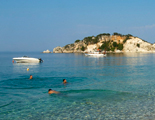
Amazing hidden beauty
Location:Gidaki
Gidaki beach, only accessed by boat, is considered to be one of the best beaches on the island and definitely the most crowded one. The boats depart from Vathi and the trip lasts about 20 minutes and costs about 10 euros. It is located at the eastern side of Ithaca, north from Filiatro bay, and its shore is pebbled with deep and blue waters. The place offers a beautiful view towards the mainland to the east and the small uninhabited islets. One can also get there by the narrow path from Schinos which is about 10 minutes on foot. There is also a canteen on the spot.
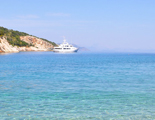
The most popular organized beach on the island
Location:Filiatro
By following the road heading east from Vathi, you will find Filiatro beach, on the eastern part of the island. The access is easy as there are also many signs on the road leading you to this long coast with a parking space before and a beach bar at its entrance. Filiatro beach is organized with umbrellas and sun beds and it even offers water sports. Due to its easy access along with being one of the very few organized beaches on the island, Filiatro is pretty popular and offers shallow warm waters, ideal for young children.
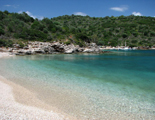
A hidden heaven behind an ordinary coast
Location:Sarakiniko
Sarakiniko beach is located on the south-eastern part of the island and can be found by following the road leading out of the settlement of Vathi to the east. At the end of the road an ordinary and usually empty coast with the fish boats and fishing nets is found but right behind a small hill leading to Sarakiniko bay. Sarakiniko is a secluded heaven with light grey pebbles and deep emerald waters embraced by the trees on the cliffs around it. The beach is totally secluded and unorganised so food and drink supplies along with an umbrella are a must, especially if you are planning a day-excursion (which we highly recommend here). If you want to relax away from popular or crowded spots, this would be a good choice.
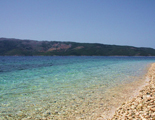
Swimming in a sea canal between Ithaca and Kefalonia
Location:Aspros Gialos
Aspros Gialos is located on the west coast of the island with a marvelous view to Kefalonia. The beach is accessed by the main road from Vathi to the north going towards Agios Ioannis village. The road signs are pretty helpful as you will need to find the turn to descent to the beach, located at the foot of Mount Niritos. After you park the car at the end of the road, you follow a small trail and you will be rewarded with an amazing coast with the marvellous pebbled shore and quite deep and cold waters. Right opposite to the beach the eastern shore of Kefalonia is visible. Aspros Gialos is a very calm and quiet beach as it is not organized and never crowded.
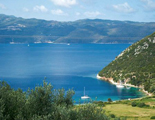
A calm harbour
Location:Polis
By following the descending road from the mountainous village of Stavros the small harbour of Polis is found. The beach is sandy with deep blue and green waters while some trees offer natural shade. At polis beach total relaxation, sea gazing and an amazing natural scenery promise a beautiful day at the beach. The place also offers a large parking space and on the beach you will find a canteen too for the necessary supplies.
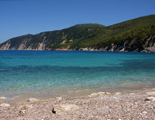
Embraced by the verdurous cliffs
Location:Afales
Located on the north part of the island in Afales bay the homonymous beach is found. To access the beach you have to take the road from Platrithias village to the north passing through a marvellous green scenery. The shore is pebbled with a few scattered rocks and the waters are deep blue and cold. There are also two other hidden small beaches which you may visit if you climb over the rocks to the left. The place is pure and secluded and the steep cliffs offer protection from the strong sun. In the same bay there are also beaches that can only be accessed by boat.
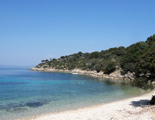
Right next to the graphic Kioni
Location:Kioni
The picturesque village of Kioni is located almost 24 km from Vathi to the north east part of the island. The beach consists in a small pebbled coast with clear waters ideal for swimming and snorkeling. Kioni beach is mostly preferred not only for its charming coast but also for its scenic natural green landscape. It is not organized but there is a café operating in the area and is also pretty close to Kioni settlement where you will find anything you might need.
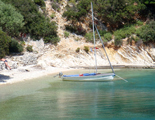
A collection of charming coves
Location:Frikes
On the road from Frikes to Kioni several small bays and havens are found which are easily accessible. You may park your vehicle on the side of the road and descend the steps to meet the engulfed beautiful small or even private beaches shaded by the trees that are always present like a green blanket almost covering the coast. Those charming coves near Frikes settlement are pebbled with clear, calm emerald waters and some tamarisk trees for natural shade. Just mind to get there early enough to find a tree to lay under!
A secluded treasure
Location:Afales
Kaminia beach is located on the south east coast of the island and can be accessed through the main road and then a dirt road leading eventually to the shore. The beach is pebbled with clear waters, not organized and, thus, calm. The scenery is lovely with the green hills climbing down to the small bay and diluting into the blue.
One of the most popular beaches on Ithaca
Location:Loutsa
Loutsa beach is located very near Vathy, after about 1 km on the road leaving the village. The beach is organized with umbrellas, sun beds and a canteen and, due to its proximity to Vathy, it is also very popular and usually crowded. Its waters are clean, clear and shallow, making it ideal for families with young children.
The most treasured beach!
Location:Platys Ammos
Platys Ammos beach is one of the best beaches on Ithaca, located at Afales bay but only accessed by boat. The shore is sandy and pebbled and the waters emerald forming a beautiful symphony of colours with the ever present trees at the background. Platys Ammos beach is actually formed on the foot of a steep shiny white sand cliff and it is a favorite one for yachts and small boats that usually anchor in its bay.
Untouched natural beauty at its most!
Location:Marmakas
North from Platrithias village through the dirt road leading to the north east coast of Ithaca Marmakas beach is found. The name derives from the sea bottom which is covered with white pebbles and look like marbles which reflect the sunlight. The waters are blue and deep, the shore is sandy and the trees around it offer abundant natural shade to the visitors. Marmakas beach is a tranquil haven, ideal for absolute seclusion and relaxation.
Get lost in a secluded bay
Location:Mavronas
On the north-eastern part of the island with access from Rachi area, close to Kioni, through an easy dirt road, Mavronas beach is located nestled in the homonymous bay. The shore is small and pebbled with clear blue deep waters. You will find peace and tranquility as the place is completely secluded and literally out of the passengers' sight.
Map
Local Specialties & Recipes
Savoro Fish
This one is a special cold dish made by fish fillets usually from whitebait, bogue or red mullet. The fish is floured and fried in olive oil. Then the onions, the garlic and rosemary are put in a frying pan with olive oil and are sautéed. As soon as the mixture is ready, red wine and vinegar is added along with raisins and salt. The fillets are marinated with the mixture and put in the fridge. A special dish ideal for summer days.
Chicken Tserepa
The chicken is cut into portions and then marinated with a mixture made of salt, pepper, smashed garlic and olive oil for a fortnight. Tomatoes cut in large pieces with tomato juice, a glass of white wine and lemon juice are put in a pan along with the chicken, potatoes and peppers. Salt and pepper is added and the pan is put in the oven. Oregano is added right before the dish is ready.
In the traditional way a tserepa (clay pot) is used instead of a pan which, instead of the oven, is put over the charcoal.
Rovani
A traditional sweet delight made by ground rise with honey, sugar, olive oil, vanilla essence and cloves baked in the oven.
Poulenta
A traditional crème served hot (winter dish). Raisins are boiled in water; then milk is added with sugar and corn flour and stirred until the mixture is solid. The mixture is put in a bowl and cinnamon is added on top.
Local Products
Local Products
Olive Oil
On the island the local variety of olive trees called “Thiako” thrives which produces a fine virgin olive oil.
Wine
From the local varieties, which are certified organic products, the sweet red Mavrodaphne and a sec White wine called “Thiako” are produced.
Sweets
There is a variety of traditional home made sweets like quince, sweet arbutus berries, sweet pear and jams which will excite your senses.
Other Products
A variety of the famous soft white cheese “feta” is produced on Ithaca.
Also, the locally produced meat derives from a special kind of local sheep called “erythropo”.
Events
Religious Feasts
Usually the religious feasts, after the morning church service, are celebrated by great outdoor fairs which also involve a whole lot of traditional music, dances, food and drink.
Find below some of the most popular religious feasts on Ithaca.
- On the 30th of June the celebration of Saints Apostoles in Frikes is held.
- On the 17th of July Agia Marina is celebrated in Exoghi.
- In Kioni annually on the 20th of July takes place the celebration of Prophet Elias.
- The Metamorphosis of the Savior is celebrated on the 5th and 6th of August every year in Stavros.
- On the 15th of August the celebration of Panagia (Virgin Mary) is held in Platrithias. On the 14th the celebration of Panagia in Anogi is also held.
Cycladia Tips
Useful tips for a Pleasant Stay
Try to avoid the direct exposure under the sun for extended periods of time, especially from 11.00 to 16.00. You should often use a high factor sun cream or oil to get the maximum protection and get a nice sun tan.
A number of beautiful beaches are set in semi secluded spots, so you should take your umbrella or supplies of water and food with you in order to enjoy the majestically beautiful beaches for as long as possible.
You should be very careful when you drive a motorbike because the roads may surprise you (narrowing and winding) while, at some points the road, is not sufficiently illuminated.
The island is gifted with marvellous beaches and waters but do not miss the chance to visit the beautiful villages and settlements set on the mountains. The majestic vies of the Ionian Sea and the nearby island of Kefalonia will captivate you!
Except for the beaches with easy access there are several that can only be reached by boat. You could rent a small boat from Kioni, Frikes or Vathy to explore those hidden gems and live an unforgettable experience
Shops & Galleries
Shopping in Ithaca
While on Ithaca you can find some of the most representative works of art of the Greek tradition. Most of the shops are located in Vathy.
Art objects and Embroideries
Dia Heiros
Handmade objects of art made purely from natural resources.
Vathy, Ithaca
Tel. +30 26740 33131
George Simiris – Ithaca Embroideries
Fine handmade embroideries made with the unique and special Ithacan “Fillet”.
Vathy, Ithaca
Tel. +30 26740 32 800
 Ithaca Travel Guide
Ithaca Travel Guide

 Print this page
Print this page